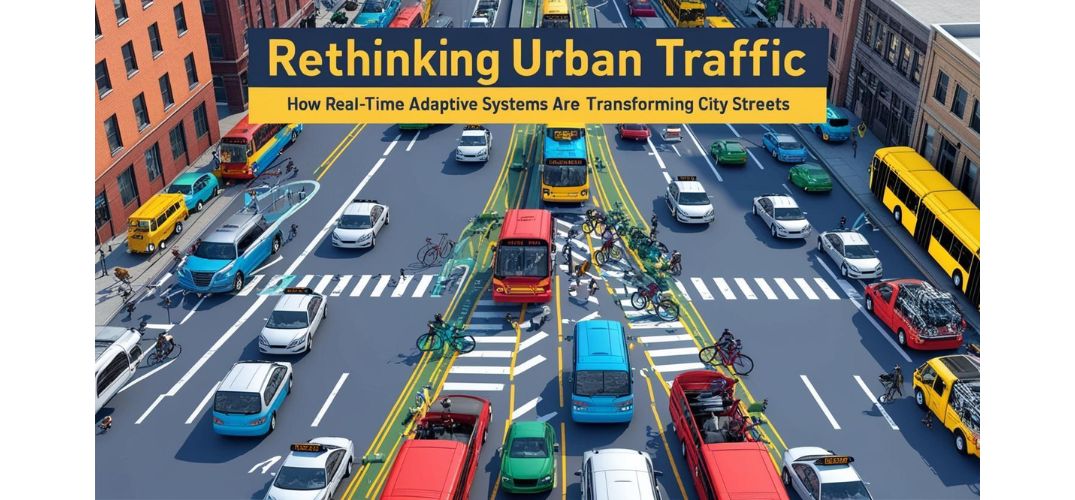In this modern era, Anandan Dhanaraj, a seasoned expert in real-time data processing systems, explores adaptive signal control innovations aimed at reducing urban traffic congestion. This article highlights how real-time data processing is shaping the future of traffic management.
The End of Static Timetables
Traditional traffic signals rely on rigid, pre-scheduled timing plans that don’t adapt to real-time traffic. These outdated systems often lead to delays, fuel wastage, and higher emissions. Adaptive signal control responds dynamically to live conditions, tailoring timing based on current congestion levels or incidents bringing flexibility to intersections once known for bottlenecks. This responsiveness ensures a smoother experience for drivers, especially in areas with fluctuating traffic due to events or construction.
Real-Time Data as the New Engine
The foundation of adaptive control lies in sensor-driven data infrastructure. Sensors like inductive loops, video cameras, and radar collect traffic data, which analytics frameworks process in milliseconds. These systems interpret traffic volumes, queue lengths, turning movements, and vehicle speeds to optimize performance. Additionally, data validation and fusion techniques ensure that the system operates on accurate and holistic traffic snapshots, allowing better coordination across intersections.
Intelligence Behind the Lights
Sophisticated control algorithms optimize signal timing using continuous feedback. Whether rule-based or optimization-driven, they allocate green time based on real conditions. These algorithms calculate decisions in milliseconds, balancing immediate needs with broader network efficiency goals. Some advanced systems can even learn from past patterns to fine-tune their timing strategies over time, evolving alongside the changing behavior of commuters and seasonal traffic variations.
Seamless Urban Integration
Effective deployment involves upgrading controllers, communication protocols, and ensuring compatibility with emergency and transit systems. Sensor placement both at intersections and upstream captures vehicle presence and approach speeds, enabling informed and proactive signal responses. Integration also extends to cloud-based platforms that allow centralized monitoring and real-time adjustments from control centers, enhancing scalability and maintenance capabilities.
Quantifying the Gains
Adaptive systems reduce travel times by up to 40% and vehicle stops by 60%. They also cut emissions by 18% and fuel use by nearly 9%. Intersection throughput rises without adding road capacity. Travel time becomes more predictable, while crash rates decline making streets safer. These gains translate into enhanced commuter satisfaction and more efficient logistics for commercial transport providers.
High Returns on Smart Investments
Though initial costs range from $30,000 to $60,000 per intersection, benefits outweigh expenses. With benefit-cost ratios between 9:1 and 25:1, cities save through reduced fuel costs, lower emissions, and improved commute times. Maintenance costs remain modest, enhancing long-term value. Moreover, savings in emergency response efficiency and reductions in road rage-related incidents further amplify the societal benefits.
Tomorrow’s Infrastructure, Today
Future adaptive systems will integrate with transit, parking, and emergency platforms. Standardized data protocols allow coordinated citywide responses. Machine learning enhances predictions, with models learning from traffic trends to optimize signal behavior without relying solely on traditional traffic models. These smart systems may eventually interact with energy grids and environmental sensors to prioritize sustainable travel corridors.
Vehicles That Talk Back
Vehicle-to-infrastructure (V2I) communication enables signals to receive data directly from vehicles like speed and route offering granular insights far beyond traditional detection. As V2I adoption grows, signals will respond not just to traffic presence but to vehicle-specific needs. These systems could, for example, prioritize buses, reduce wait times for high-occupancy vehicles, or adjust timing for emergency responders en route.
Making Smart Cities More Accessible
Scaling remains a challenge, but cloud-based platforms and modular systems are making deployment more affordable. Tools like remote diagnostics and predictive maintenance reduce technical barriers, enabling broader adoption even for resource-limited municipalities. Collaboration between public agencies and tech developers is also streamlining procurement, implementation, and training processes to support sustained performance.
In conclusion, replacing static schedules with real-time strategies, adaptive signal control is redefining how cities manage traffic. These systems deliver real benefits: shorter commutes, cleaner air, and economic savings. As Anandan Dhanaraj emphasizes, adaptive control is a crucial step toward smarter, more livable cities. Its ongoing evolution, especially through machine learning and V2I integration, positions it as a central pillar of future-ready urban mobility systems.





























